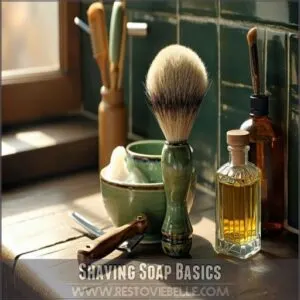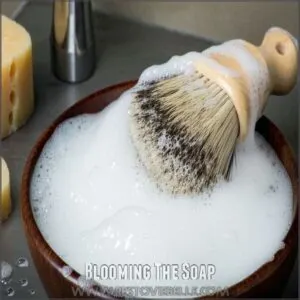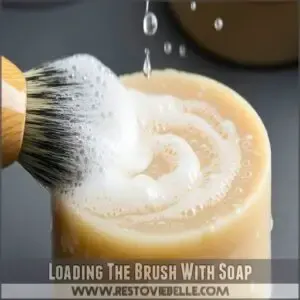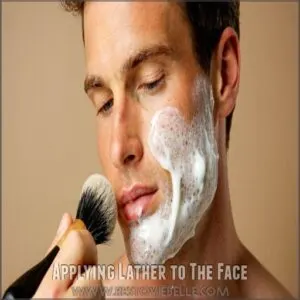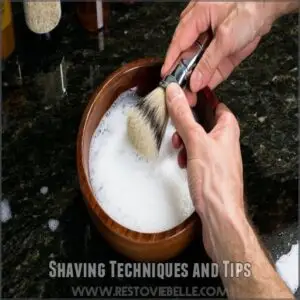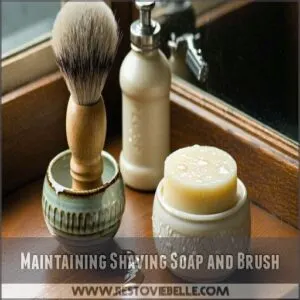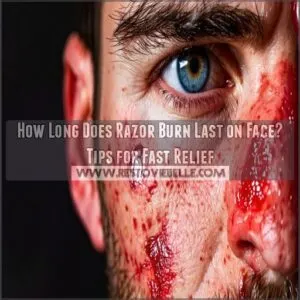This site is supported by our readers. We may earn a commission, at no cost to you, if you purchase through links.
 Want to transform your shaving routine from dull to delightful? Learning how to use shaving soap is your ticket to a smoother, more luxurious experience.
Want to transform your shaving routine from dull to delightful? Learning how to use shaving soap is your ticket to a smoother, more luxurious experience.
Start by grabbing a quality shaving brush and softening your facial hair with warm water. Load your brush with a good shaving soap, working it into a rich, creamy lather that’ll make your skin sing. Aim for a thick, cushiony consistency that’ll help your razor glide like silk.
Apply the lather in circular motions, creating a protective barrier that’ll keep your skin hydrated and irritation-free. Master this technique, and you’re not just shaving – you’re crafting a precision grooming art.
Table Of Contents
- Key Takeaways
- Shaving Soap Basics
- Using Shaving Soap Effectively
- Preparing for a Shave
- Building and Applying Lather
- Shaving Techniques and Tips
- Maintaining Shaving Soap and Brush
- Frequently Asked Questions (FAQs)
- How do you shave with soap?
- What makes a good shave soap?
- Can shave soap be used as a soap?
- What is a shaving soap used for?
- Should you use soft or wet shaving soap?
- How can I make shaving soap softer?
- How do I use shave soap?
- How to make a lather with shaving soap?
- Is it better to shave with or without soap?
- Which is better, shaving cream or shaving soap?
- Conclusion
Key Takeaways
- You’ll transform your shaving routine by mastering the art of lathering – use a quality shaving brush, work the soap into a rich, creamy foam, and apply in gentle circular motions for maximum skin protection.
- Choose the right shaving soap based on your skin type, with options like tallow-based for superior glide or glycerin-based for sensitive skin, understanding that each type offers unique benefits for your grooming experience.
- Your technique matters more than perfection: hold your razor at a 30-degree angle, let the razor’s weight do the work, and rinse frequently to prevent soap buildup and ensure a smooth, irritation-free shave.
- Maintain your shaving tools meticulously – clean your brush after each use, store your soap in a cool, dry place, and air dry your brush standing upright to extend the life of your grooming equipment and guarantee consistently great shaves.
Shaving Soap Basics
Using shaving soap might feel old-fashioned, but it’s a must-have for a smooth and satisfying shave.
All you need is the right tools, a little patience, and a good lather to take your grooming game up a notch.
Necessary Tools and Equipment
To get the most out of your shaving soap, you’ll need the right tools.
These essentials make lathering smooth and shaving efficient:
- Shaving brush: Opt for soft or firm bristles, depending on your preference.
- Shaving bowl or mug: Perfect for whipping up rich lather.
- Lather tray: Handy for organized lathering.
- Soap container: Keeps soap fresh.
- Razor handle: Firm grip for precision shaving.
Benefits of Using Shaving Soap
Shaving soap elevates your grooming game, offering more than just a clean shave. Its rich lather guarantees a smooth razor glide, nourishing your skin and softening hairs for a comfortable shave.
Unlike canned creams, shaving soap benefits include hydration and longer-lasting use. Mastering the shaving soap howto transforms your routine into a skillful ritual.
To find the best shaving soaps, consider factors such as skin sensitivity and lather quality. Shaving soap tips? Practice lathering for perfection!
Types of Shaving Soap
Not all shaving soaps are created equal, and choosing the right one can transform your shave. There are a few popular types you’ll encounter:
- Tallow-based vs. glycerin-based: Tallow offers super glide, while glycerin pampers sensitive skin.
- Triple-milled soaps: Denser soaps that last longer and lather beautifully.
- Artisan or vegan options: Perfect for those chasing natural ingredients or sustainable shaving soap benefits.
For a more traditional approach, many shavers still prefer tallow shaving due to its unique properties.
Using Shaving Soap Effectively
Using shaving soap effectively means nailing your lather consistency and brush techniques. To achieve the best results, understanding shaving brush benefits is important for a smooth shave. Start by loading your brush properly—too much water, and you’ve got a slippery mess; too little, and the lather falls flat. Work the soap into a thick, creamy lather that sticks.
Here’s a quick guide:
| Step | Details |
|---|---|
| Wet Your Brush | Use warm water, not dripping. |
| Load with Soap | Swirl brush on soap for 30-45 seconds. |
| Build the Lather | Whip in a bowl until creamy, rich lather. |
Focus on preparation–flat lather, flat shave!
Preparing for a Shave
Getting ready for a clean, smooth shave starts with proper prep work, and it’s easier than you think.
By softening your skin and getting your tools ready, you’ll set yourself up for a comfortable, irritation-free shave.
Softening The Skin
Softening your skin is the key to a smooth shave. Start with warm water to open pores and prep for gentle exfoliation. Adding soothing agents like glycerin soap also benefits all skin types, especially sensitive ones, by providing hydration. Following sensitive skin care routines can further improve your shaving experience.
Here’s how:
- Wash your face with warm water.
- Massage soap into your skin.
- Allow it to soak briefly.
- Rinse thoroughly.
- Pat dry gently for face prep shaving.
Preparing The Shaving Brush
Before diving into lather creation, your shaving brush needs some TLC. Choose a medium-soft bristle brush that’ll treat your skin right – natural badger or synthetic options work wonders.
Soak the brush in warm water to soften the bristles and prep for smooth application.
Give it a gentle shake to remove excess water, ensuring it’s damp but not dripping wet.
Creating a Rich Lather
From the moment you begin creating a rich lather with your shaving soap, the water ratio becomes your secret weapon for a smooth shave. Mastering the art of lather takes practice and patience.
- Feel the satisfaction of perfectly whipped foam
- Experience the transformation of simple soap into silky smoothness
- Discover your inner shaving artisan with each brush stroke
Your technique matters more than perfection – embrace the journey of lathering.
Building and Applying Lather
You’ll need to master the art of creating a rich, creamy lather to transform your shave from ordinary to exceptional.
With the right technique and a quality shaving brush, you’ll learn to whip up a luxurious foam that’ll coat your skin and soften your stubble for a smooth, comfortable shaving experience.
Blooming The Soap
After prepping your skin, it’s time to bloom your shaving soap—a game-changing hydration technique that preps your soap for epic lathering. Think of it like waking up your soap from a deep slumber.
Using a shaving brush can greatly enhance the lathering process. Here’s a quick guide to getting it right:
| Blooming Method | Time Needed |
|---|---|
| Hot Water Soak | 2-3 minutes |
| Steam Method | 1-2 minutes |
| Quick Splash | 30 seconds |
Soft, supple soap equals smoother shaves.
Loading The Brush With Soap
Whipping your shaving brush into the soap requires finesse. Gently swirl the damp brush in circular motions, pressing softly to load it with soap.
Aim for a light touch that gradually builds soap onto the bristles without oversaturating.
Your goal? A brush that’s evenly coated and ready to create the perfect lather. Practice makes perfect with these soap loading techniques.
Applying Lather to The Face
How do you transform that perfect lather into a smooth shaving experience? Gently use your shaving brush to apply the soap in circular motions across your face.
The bristles work their magic, exfoliating and distributing the lather evenly. Mastering face lathering techniques is essential for achieving the best results.
Focus on complete coverage, ensuring each section gets that rich, protective layer of shaving soap. Your technique matters – soft, deliberate strokes make all the difference.
Shaving Techniques and Tips
Master your shaving technique with the right tools and precision to transform your daily grooming routine.
Whether you’re using a safety razor or a straight-edge razor, understanding key techniques will help you avoid common mistakes and achieve a smooth, irritation-free shave.
Shaving With a Safety Razor
After mastering your lather’s perfect consistency, it’s time to wield your safety razor with precision.
Hold the razor at a 30-degree angle, letting the weight do the work—no need to apply extra pressure.
For more information on traditional shaving, consider exploring online resources.
Take smooth, controlled strokes, rinsing the blade frequently to prevent soap buildup.
Your razor maintenance matters: keep it clean, sharp, and aligned for a comfortable, nick-free experience.
Shaving With a Straight Edge Razor
If you’ve mastered the safety razor, straight edge shaving takes your skill to the next level.
A straight razor demands respect and precision – it’s the samurai sword of shaving tools.
Keep your blade razor-sharp and your hand steady. Grip the straight edge at a 30-degree angle, using gentle, controlled strokes.
Your shaving soap’s rich lather becomes your best ally in this delicate dance of blade and skin.
Avoiding Common Mistakes
Mastering straight-edge razor techniques doesn’t guarantee a perfect shave.
Watch out for soap overloading, which gunks up your blade and ruins your smooth glide. Keep your lather light and even, preventing razor clogging that can lead to nasty nicks.
Pay attention to brush maintenance and skin sensitivity. Practice makes perfect – don’t get discouraged by initial mishaps when learning this classic shaving art.
Maintaining Shaving Soap and Brush
Proper care of your shaving soap and brush can extend their lifespan and guarantee a superior shaving experience every time.
By learning a few simple maintenance techniques, you’ll keep your tools in prime condition and ready for a smooth, comfortable shave.
Cleaning The Shaving Brush
After nailing your shaving technique, keeping your shaving brush in top shape is key. Proper brush cleaning preserves its performance and extends its lifespan.
Here’s how to care for your trusted grooming companion:
- Rinse thoroughly with warm water
- Gently squeeze out excess moisture
- Use mild soap for deep cleaning
- Reshape bristles while wet
- Air dry brush standing upright
Your brush will thank you with smoother, more consistent lathers.
Storing The Shaving Soap
Your shaving soap’s longevity depends on smart storage strategies. Keep your precious puck in prime condition with these essential tips: To maintain your soap’s quality, consider using soap storage methods that prevent deterioration.
| Storage Location | Recommended Container |
|---|---|
| Cool, Dry Space | Airtight Ceramic Mug |
| Away from Heat | Ziplock Freezer Bag |
Protect your soap from moisture, sunlight, and temperature fluctuations. Rotate usage, inspect periodically, and preserve your investment with these simple shaving soap storage techniques that’ll keep your lather smooth and consistent.
Drying and Maintaining The Brush
Rinse your shaving brush thoroughly after each use, shaking out excess water to prevent soap residue buildup.
Gently squeeze the bristles, avoiding harsh twisting that could damage the delicate fibers.
Store the brush upright in a well-ventilated area, allowing air circulation to dry completely. Clean the handle periodically to maintain hygiene and extend your brush’s lifespan.
Frequently Asked Questions (FAQs)
How do you shave with soap?
Softening facial hair with warm water, create a rich lather using a brush and shaving soap.
Apply in circular motions, then carefully shave with a sharp razor, rinsing between strokes for a smooth, irritation-free experience.
What makes a good shave soap?
A good shave soap delivers rich, moisturizing lather with natural ingredients like glycerin and essential oils.
It protects your skin, softens hair, and glides smoothly under your razor for a comfortable, irritation-free shaving experience.
Can shave soap be used as a soap?
Slippery, specialized shave soap shouldn’t substitute standard soap.
You’ll find its unique formula designed for lubrication during shaving, not daily cleansing.
While technically usable, it’s less effective and might dry out your skin compared to regular body soap.
What is a shaving soap used for?
Shaving soap prepares your skin for a smooth, close shave by creating a protective lather that softens facial hair, lubricates the skin, and helps your razor glide effortlessly.
While preventing irritation and nicks, it achieves the primary goal of facilitating a comfortable shaving experience.
Should you use soft or wet shaving soap?
Worried about soap consistency? You’ll want a soft, slightly wet shaving soap that loads easily onto your brush.
It creates a rich, creamy lather that glides smoothly, protecting your skin and ensuring a comfortable, close shave every time.
How can I make shaving soap softer?
Soften your stubborn shaving soap by soaking it in warm water for a few minutes before use.
Gently massage the soap to increase pliability, making lather creation smoother and your shaving experience more comfortable.
How do I use shave soap?
Lather up your razor’s best friend with a wet brush, swirling soap into a creamy cloud.
Massage the foam onto your face in circular motions, glide your razor smoothly, and rinse with cool water for a close, invigorating shave.
How to make a lather with shaving soap?
Wet your brush with warm water, then swirl it gently on the soap to build a thick, creamy lather.
Use circular motions to whip up a rich foam that’ll glide smoothly across your skin for a perfect shave.
Is it better to shave with or without soap?
Shaving without soap is like driving without oil—you’ll damage your skin.
Soap provides essential lubrication, protects against razor burn, and guarantees a smoother, more comfortable shave.
Always choose soap for a professional-grade grooming experience.
Which is better, shaving cream or shaving soap?
Soap trumps cream for a closer, smoother shave.
You’ll get better skin protection, richer lather, and longer-lasting performance.
Traditional soap requires more skill but delivers a superior, more luxurious shaving experience that’ll elevate your grooming game.
Conclusion
Smooth, supple skin starts with mastering how to use shaving soap like a pro.
You’ve learned the art of creating luxurious lather, selecting the right tools, and transforming your daily routine. Whether you’re a newbie or a seasoned shaver, these techniques will elevate your grooming game.
Embrace the ritual, protect your skin, and enjoy a closer, more comfortable shave every single time. Your face will thank you for the extra care and precision.
- https://www.beeco.green/best-safety-razors/
- https://beeco.green/facts/how-to-use-shaving-soap/
- https://www.cleanedcut.com/how-to-use-shaving-soap/
- https://cutthroatclub.com/blogs/instructions/how-to-use-shaving-soap-definitive-guide
- https://bamboozy.com/blogs/general/should-i-use-shaving-soap-with-a-safety-razor-as-a-woman
